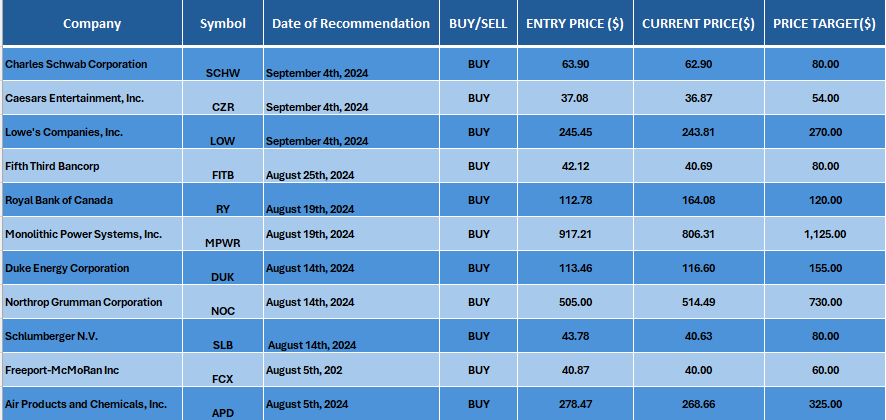
Date Issued – 20th September 2024
Markets Embrace Optimism After Digesting Positive News
Record Highs Across U.S. Markets
U.S. stocks surged on Thursday, with both the S&P 500 and Dow Jones Industrial Average closing at record highs. The tech-driven Nasdaq Composite also enjoyed its fourth-best performance of the year, powered by a rally in major tech stocks. In Asia, markets followed suit, with Japan’s Nikkei 225 rising 1.7% on Friday, supported by a 2.8% year-on-year increase in the country’s core consumer price index, aligning with market expectations.
Central Banks Hold Steady in Asia
Two key central banks in Asia made crucial rate decisions on Friday. The People’s Bank of China surprised markets by keeping its one-year and five-year loan prime rates unchanged at 3.35% and 3.85%, respectively. Meanwhile, the Bank of Japan maintained its interest rates at “around 0.25%,” a decision that met the expectations of analysts in a Reuters poll.
Tech Stocks Lead the Charge
Tech stocks took center stage after a day of reflection on the U.S. Federal Reserve’s rate cut. On Thursday, Tesla surged 7.4%, Nvidia climbed 4%, and Apple gained 3.7%. This tech rally lifted the Nasdaq by 2.5%, marking its fourth-biggest one-day rise of 2024. The index’s strongest rally this year was a 3% jump on February 22.
A “Recalibration” of Fed Policy
Federal Reserve Chair Jerome Powell’s use of the word “recalibration” provided reassurance to investors. It signaled that the Fed’s 50-basis-point rate cut wasn’t a response to economic weakness but rather a proactive shift to safeguard employment levels. This interpretation helped fuel Thursday’s market rally, noted CNBC’s Jeff Cox.
Commodities Outlook
While stock markets have rallied on the back of the Fed’s rate cut, commodity markets may follow a different trajectory. Historically, lower rates tend to drive demand for commodities such as gold, copper, and oil. However, analysts from Citi and HSBC caution that predicting commodity performance requires careful analysis of historical patterns and broader economic shifts.
Bottom Line
The markets have quickly moved past their initial reactions to the Fed’s decision. As Dinah Washington famously sang, “What a difference a day makes.” After an initial dip following the Fed’s rate cut announcement, stocks bounced back decisively, hitting record highs across major indices. The S&P 500 climbed 1.7%, breaking through the 5,700 mark for the first time to close at 5,713.64. The Dow followed suit, closing above the 42,000 threshold for the first time at 42,025.19, rising 1.26%. The Nasdaq, driven by gains in Tesla, Nvidia, and Apple, emerged as the biggest winner, surging 2.51%. While September is historically a challenging month for stocks, historical data shows that when the S&P 500 reaches new highs in September, the fourth quarter tends to perform well. According to Oppenheimer, this pattern has occurred in 20 out of the last 22 instances since 1950.
BMO’s bullish outlook reflects this optimism. The bank raised its year-end target for the S&P 500 to 6,100, representing an 8.6% increase from Wednesday’s close the most aggressive projection on Wall Street. “Much like our last target increase in May, we continue to be surprised by the strength of market gains,” wrote Chief Investment Strategist Brian Belski.
As Washington’s song concludes, “What a difference a day makes, and the difference is you.” For now, Powell may feel like the central figure in this market serenade.
China Holds Lending Rates Steady Amid Fed Cuts, but Stimulus Expected Soon
In an unexpected move, China left its benchmark lending rates unchanged at Friday’s monthly fixing, surprising market participants who had anticipated a rate cut following the U.S. Federal Reserve’s aggressive interest rate reduction earlier this week. Despite this decision, most analysts believe China will introduce additional stimulus measures in the near future to support its slowing economy, now afforded more room for monetary easing thanks to the Fed’s rate cuts. The People’s Bank of China (PBOC) maintained the one-year loan prime rate (LPR) at 3.35%, while the five-year LPR remained unchanged at 3.85%. This decision caught many off-guard, as a Reuters survey of 39 market participants had found that 69% expected cuts to both rates.
Further Stimulus Likely on the Horizon
While no immediate action was taken, many experts believe that China’s policymakers are preparing a broader stimulus package, which could include a rate cut. “The rate cut is likely to be part of a larger policy package under review by senior officials,” said Xing Zhaopeng, Senior China Strategist at ANZ. He also noted that current economic indicators, including a slowdown in August’s credit lending and activity, support the case for a reduction. Analysts expect that such a move will help China’s economy meet its increasingly challenging 2024 growth target. The five-year LPR, which influences mortgage rates, is likely to be reduced in conjunction with these broader efforts. A more significant rate cut is anticipated by the fourth quarter as part of a comprehensive economic support strategy.
Pressure to Meet Growth Targets
China’s faltering economic performance has led global institutions to lower their 2024 growth forecasts for the country, now below the government’s target of around 5%. In response, President Xi Jinping recently emphasized the need for additional measures to achieve the nation’s economic and social development goals, as reported by state media. With Beijing’s room to maneuver expanding after the U.S. Fed’s rate cut, expectations are building for an imminent easing of monetary policy. “Lackluster growth demands policy easing, and the Fed’s cuts provide the necessary space for the PBOC to act,” analysts at Commerzbank noted.
Navigating Global Policy Divergence
For the past two years, China has been constrained in its monetary policy due to a diverging path from other major economies, particularly the United States. The yuan’s weakness has also complicated efforts to ease policy. However, the Fed’s recent 50-basis-point cut has opened a window for the PBOC to reduce rates without exerting excessive downward pressure on the yuan. Most loans in China are tied to the one-year LPR, while the five-year rate is used to set mortgage rates. With economic growth lagging and pressure mounting to meet development targets, it appears increasingly likely that rate cuts will be implemented in the coming months to stimulate demand and stabilize the property market. In the current context of global economic uncertainty, all eyes will be on China’s next steps in what may be a crucial period for both domestic recovery and broader international financial dynamics.

Natural Gas and Oil Forecast: Brent Eyes $75 as Bullish Momentum Builds
Market Overview
Oil prices saw a slight pullback on Friday but are poised to close the week on a positive note, driven by U.S. Federal Reserve rate cuts and a decline in crude stockpiles. The Fed’s 50 basis points interest rate reduction has lifted economic sentiment, potentially boosting energy demand. Geopolitical tensions in the Middle East further support prices, despite headwinds from weaker Chinese economic activity and reduced refinery output. Analysts suggest that oil prices will hover between $70 and $75 over the next quarter, but they anticipate potential declines heading into 2025 as broader market conditions evolve.
Natural Gas Price Forecast
Current Price: $2.351 (down 0.04%)
Natural Gas (NG) is trading slightly below its pivot point of $2.36, indicating mild bearish pressure. Immediate resistance is set at $2.43, with further targets at $2.48 and $2.54 if bullish sentiment gains traction. On the downside, key support sits at $2.28, with additional levels at $2.22 and $2.16. A break below these levels could signal increased selling pressure.
Technically, the 50-day EMA at $2.30 offers near-term support, while the 200-day EMA at $2.22 reinforces the broader support zone. If prices remain below the $2.36 pivot, bearish sentiment may dominate, but a breakout above this point could reinvigorate bullish momentum.
WTI Oil Price Forecast
Current Price: $70.97 (down 0.14%)
WTI Crude Oil (USOIL) is holding just above its pivot point at $70.54, a critical support zone. As long as prices stay above this level, the outlook remains bullish, with additional support at the 50-day EMA of $69.74. Immediate resistance is positioned at $71.88, followed by $72.95, and an extended target of $74.24 if upward momentum persists.
On the downside, key support is located at $68.45, and a break below this level could lead to increased selling pressure, potentially shifting the near-term outlook to bearish.
Brent Oil Price Forecast
Current Price: $74.66 (down 0.29%)
Brent Crude Oil (UKOIL) is trading above a crucial pivot point of $74.02, maintaining a bullish outlook. The 50-day EMA at $73.18 provides robust support, signaling that buyers still control the market. Immediate resistance lies at $75.19, with further targets at $76.24 and $77.45 if the bullish momentum continues to build. On the downside, key support levels are at $72.39, followed by $71.05 and $69.84. The formation of a bullish engulfing candle suggests a potential breakout, and the upward channel supports continued buying pressure. Should Brent break above $75.19, the market may see stronger gains in the near future.
Conclusion
Both WTI and Brent crude are poised for further gains if bullish momentum holds, with Brent potentially breaking the $75 barrier. Natural gas remains range-bound, but a break above $2.36 could shift market sentiment in its favor.
Gold (XAU) Daily Outlook: Bullish Trend Eyes $2,600 Amid Fed Rate Cuts
Market Overview
Gold prices (XAU/USD) are experiencing a sustained rally, nearing a record high of $2,595, driven by the Federal Reserve’s recent aggressive interest rate cut. This upward momentum is expected to persist, fueled by growing market anticipation of further Fed easing by year-end, which is pressuring the US Dollar (USD) towards year-to-date lows. As the dollar weakens, gold’s status as a safe-haven asset is attracting more investors, enhancing its appeal as a store of value in uncertain economic times.
Gold’s Rally Backed by a Weaker Dollar and Economic Concerns
The US dollar has been under pressure following the Fed’s 50 basis points rate cut, making dollar-denominated assets like gold more attractive. Fed policymakers have signaled the potential for additional cuts, with borrowing rates projected to fall to 3.4% by 2025 and 2.9% by 2026, further weakening the dollar. While recent positive economic indicators such as a drop in jobless claims to 219,000 and an unexpected rise in the Philadelphia Fed’s manufacturing index haven’t reversed the dollar’s slide, concerns over economic growth and slowing activity in China have kept the greenback under pressure. This backdrop has bolstered gold’s standing as a non-yielding asset.
Increased Safe-Haven Demand Amid Global Uncertainty
Beyond monetary policy, rising concerns over economic slowdowns in both the US and China are contributing to higher gold prices. Geopolitical tensions, particularly in the Middle East and Eastern Europe, along with uncertainty in the US ahead of the upcoming presidential election, are also pushing demand for safe-haven investments like gold. Given the volatile economic and geopolitical landscape, analysts anticipate further upward momentum for gold, projecting prices to surpass $2,600 in the coming weeks as investor demand remains robust.
Short-Term Forecast
Gold (XAU/USD) continues to push higher, approaching key resistance at $2,604. With support levels anchored at $2,585, the ongoing bullish sentiment is expected to drive prices beyond the $2,600 mark, underpinned by a weakening US dollar and continued Fed rate cuts.
Technical Analysis
Currently trading at $2,593.65 (+0.23%), gold is exhibiting strong upward momentum. The pivot point at $2,585.89 serves as critical support, sustaining the rally. Immediate resistance lies at $2,604.25, with further resistance targets at $2,618.20 and $2,632.15. On the downside, key support levels include $2,573.90, $2,560.25, and $2,547.22. The 50-day EMA at $2,560.61 reinforces near-term support, while the 200-day EMA at $2,505.77 highlights the broader bullish trend. A recent bullish engulfing candle pattern suggests continued gains, though a break below the $2,585 pivot could invite selling pressure, shifting the short-term outlook. Overall, gold remains well-positioned to reach new highs, with the combination of economic uncertainty, a weakening dollar, and geopolitical risk providing a favorable environment for further price increases.
Indonesian Rupiah Set for Best Week Since January as Bonds Surge
Market Overview
The Indonesian rupiah is on track for its strongest weekly performance since January, bolstered by a rally in the country’s bonds and rising investor inflows. Bank Indonesia’s decision to allow the rupiah to appreciate further has contributed to its surge, with the currency climbing as much as 1% on Friday to 15,080 per U.S. dollar, bringing its weekly gain to approximately 2.1%. This places the rupiah among the top performers in emerging markets. Simultaneously, the yield on Indonesia’s 10-year government bonds dropped to its lowest level in a year, reflecting strong demand from foreign investors.
Appeal of Southeast Asian Assets Grows
Southeast Asian assets, including Indonesia’s, are gaining favor among global investors seeking higher returns amid the U.S. Federal Reserve’s monetary easing cycle. Indonesia’s surprise interest-rate cut earlier this week has heightened the allure of its bonds and currency, with analysts forecasting further easing from the central bank. “Rupiah strength is underpinned by increased interest in Indonesian government bonds,” said Alan Lau, a currency strategist at Maybank in Singapore. Lau noted that Bank Indonesia is in a more favorable position compared to other central banks in the region, allowing for continued easing, which has amplified the attractiveness of Indonesian assets.
Rupiah Strength and Bond Inflows
Indonesian bonds are set for their fifth consecutive month of net inflows, marking the longest streak of inflows since 2017. Bank Indonesia has allowed the rupiah to strengthen, refraining from market intervention on Friday, according to Edi Susianto, the central bank’s executive director for monetary management. He reassured that the currency’s volatility remains manageable. Traders are closely monitoring the 15,000-per-dollar level, seen as the next key resistance point for the rupiah. “While markets might continue to favor the rupiah, caution could increase as it approaches the key psychological barrier of 15,000,” said Jeffrey Zhang, a strategist at Credit Agricole CIB in Hong Kong.
Conclusion
As the rupiah gains momentum and bonds attract more inflows, Indonesia’s financial markets are seeing heightened interest. With the central bank poised for further easing, the rupiah may continue to strengthen, although traders are mindful of potential resistance at key levels.
Find below some of our Buy/Sell Recommendations. Balfour Capital Group is a distinguished global boutique investment management firm with $400 million AUM and over 1000 Clients.

Disclaimer: This post provides financial insights for informational purposes only. It does not constitute financial advice or recommendations for investment decisions.

